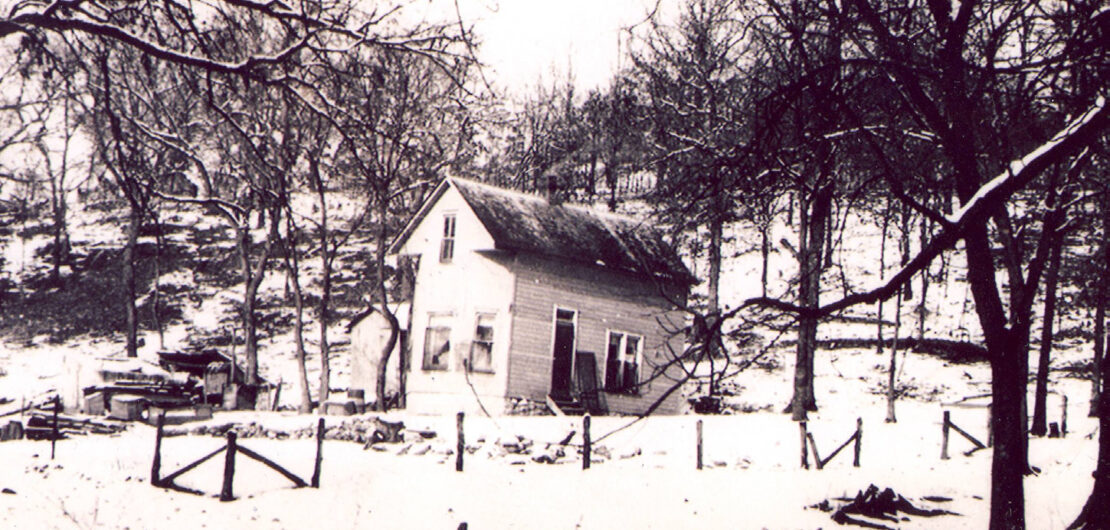 From this Corner
From this Corner
On The Banks Of Lost Creek
FROM THIS CORNER
By
Glenna J. Wallace
ON THE BANKS OF LOST CREEK
It sat not far from the banks of lost Creek. Lora Greenfield Smith remembers it as “the Pink House.” Dee Nelson Griffith remembers it as the house where she grew up and her youngest brother Butch was born. Butch Nelson remembers it as the house that had a cave near it where he frequently played. Some remember it as the “Shawnee House” because Shawnee Indians usually lived there. I remember it as the Dushane House, not Chief Dave and Allie’s home place, but the Dushane House because so many Dushanes lived there throughout the years.
Not far from the banks of Lost Creek, Lora Greenfield Smith remembers it as “the Pink house.”
The house was there when Nina Dushane Greenfield sold the 58.19 acres located in the Shawnee Reserve back in 1937. Nina, her husband and their children had previously moved to the area of Colony, Oklahoma, located in the Kiowas Agency. In a recent letter dated May 2009, Nina’s daughter Lora recalls visiting the house and Lost Creek. “When I was a little girl, my mother Nina (Dushane) Greenfield and my sister Norma (Greenfield) and I went to Seneca to the ‘pink house’ in the early 1930’s to see Uncle Jim Chandler and Aunt Lena (‘Shorty’-a nickname).
“It was a joy to go to Lost Creek to play in the creek. We would take a tobacco tin container, hold it near a crawdad and back it into the can.
“We were also scared of leeches, and someone always in fun would say-‘you have a leech on your back.’ That would end the fun for Norma and me.”
Dee Nelson Griffith remembers the house as it stood in the 40’s. She never knew it was referred to as the pink house because she said it certainly was not pink when she lived there. The two-story house sat up on a knoll. When the creek flooded, which Lost Creek frequently did back then, they were stranded because even though the house never flooded, the road to it did. Dee stated that her mother and father, Vance Dushane and Forrest Nelson, lived in the house from about 1940 to 1950’s with their five children-Marcella Dee, Buddy Charles, Josephine, Carmalita, and Butch. It was Butch who was born there. Dee described the house as salt box styled and certainly not spacious. It was a two storied structure, having 2 bedrooms upstairs, 2 rooms downstairs. About five feet behind the house was a retaining wall made of field stones. Butch recalls being outside more than he remembers being inside, saying he went up and down the creek and all over those hills. His favorite haunts were the cellar and the cave.
“Pink house” on the banks of Lost Creek.
When Vance Dushane and her family moved out, another Dushane family moved in. First it was Nina Dushane’s land, then Dave Dushane was elected Chief, then Vance Dushane lived there and this time it was Madelyn Dushane, sister to Vance and daughter to Chief Dave and Allie. No wonder many remember it as the Dushane House. Madelyn Dushane Rosenow, her husband Art and their children lived in the house until it burned.
My memories from the late forties, early fifties are more of the road and the buildings leading to the house than the house itself. It stood in Oklahoma on the north bank of Lost Creek but access to the property was from Main Street, Seneca, Missouri. Main Street of Seneca runs north and south with Mill Street running east and west. The house was the final stop via Mill Street, located less than one mile west of the present stop light (the only one) on Main Street in Seneca. It may have been less than one mile but to a little girl, it seemed like it was “out in the boonies” as we used to say.
Seneca, Missouri around 1930’s.
That might be because the Pink house or the Dushane house was down Mill Street where the remains of an old distillery stood. Years earlier, a gentleman named Mr. Schreiner, some sources list Shriver, bought “a patch of ground outside the platted portion” of Seneca where in 1889 he built a distillery near Lost Creek and over portions of a spring. Just west of the distillery he added a large hay barn and some cattle sheds he filled with hay. According to an article in the November 25, 1898 Seneca News Dispatch, he then bought corn for his cattle, extracting the “spirtus frumenti” from it before feeding his heard. That distillery had the capacity of 30 gallons per day. Getting to the “house” meant passing several businesses, the old distillery, the aged barn, the sheds and who knows what else. Finally the business road then turned into a narrow, winding lane hugging Lost Creek on the south with bluffs jutting ominously on the north, ultimately opening up to a field with an isolated house standing in the middle of nowhere.
Today Mill Street in Missouri ends before reaching Eastern Shawnee land in Oklahoma. Today no remains of a distillery, a barn, or cattle sheds stand. Today pow wow grounds accessed from the Oklahoma side spread across lands formerly covered with wheat or soybeans. Today a bridge spans the stream, making the North side accessible from the Oklahoma side. Today a small age worn building that formerly housed our first nutrition program hugs earthen banks now known as Tecumseh Park. Yesterday, in fact many yesterdays ago, a two storied house with a retaining wall five feet behind it stood isolated on the banks of Lost Creek.
(Information came from personal interviews, letter written by Lora Smith, November 25, 1898 issue of Seneca News Dispatch and Seneca, Missouri The Little Town on the Border Volume 1 1981.)


